

Will's FamilyVisits for the 2023 Syrup Campaign
******************* |
|
This page will describe family time and will focus on our syrupmaking. We are the intended audience: I use these notes to augment my memory. Notwithstanding, I hope that some parts will be interesting to others, if not today, sometime. There is some repetition so that the pages of different years can stand alone. |
|
Left, below: In fall of 2022, We started a new cane patch. Will had come earlier and tilled enough for four rows, with a large middle in the center. I kept it tilled in an effort to reduce the weed-seed bank and undesireable organisms. We continued with CP 52-48 (resistant to lodging, producing syrup less susceptible to crystallization, darker syrup) and POJ (an heirloom cane that produces "fancy" syrup). Our syrup in 2023 was made from a 50:50 blend of these two varieties cut from the new patch. Right, below: This image is of CP 52-48 from the 10-year-old patch, substantive for its age. Over the years, I have filled in the blank spots left when stools died. I cut seed cane on October 24th, 2022, and planted the new cane patch that day. N.B. this old patch was planted N/S and consequently not so battered later as the new patch, planted nom. E/W. |
|
. |
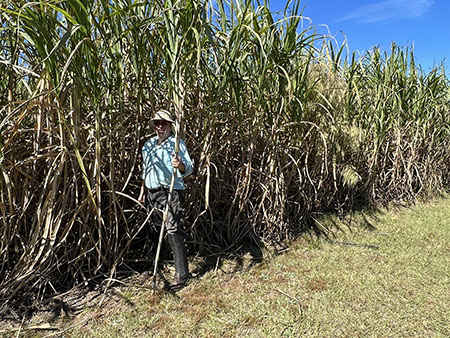 |
Left, below: Growing cane was difficult in 2023. In the first instance, there were two successive nights when the temperature dropped to 16F. (We are in Zone 9a, with an expected average minimum of 20F, certainly not prolonged periods lower than that.) The cold hit my CP 52-48 plant cane hard; only about half came up. The image, taken after the 2023 harvest, shows a skip that has been filled in. Right, below: In the second instance, along came Idalia with her strong winds. As mentioned, CP 52-48 does not readily lodge, but it breaks off--in one stool, 11 of 13 stalks were broken off. (The POJ was less affected; it was protected on the north by CP 52-48.) Altogether, I guess that the cold and wind decreased the yield of the CP 52-48 by 75%. The losses caused me to question whether we would have enough cane, so I fertilized. All equal, I would not choose to fertilize after June and our syrup was a bit darker than usual. The taste was unaffected. (Idalia also did some non-commercial thinning of my planted pines and altered the woodlot. Wind is powerful stuff.) |
|
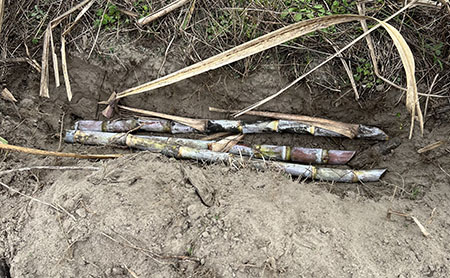 |
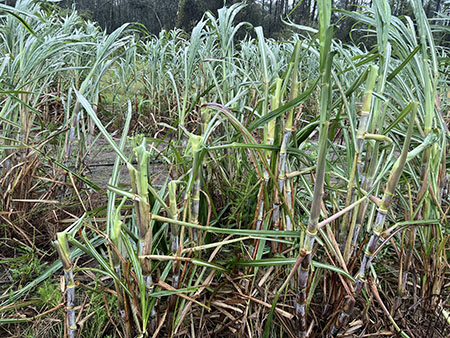 |
Left, below: Our first night together (November 2d)--after their 9-h drive--was simply devoted to being together. Nedra had gumbo ready, a request by Christine (daughter of our son, Will). Plates were set for Christine, Will, Christy (Will's wife), Harrison (Will's son), and the old folks. |
|
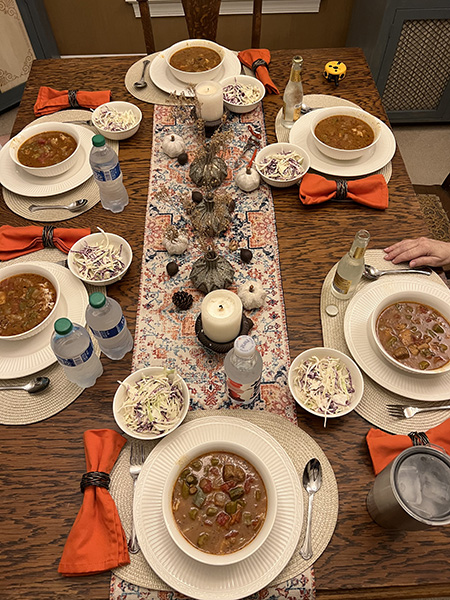 |
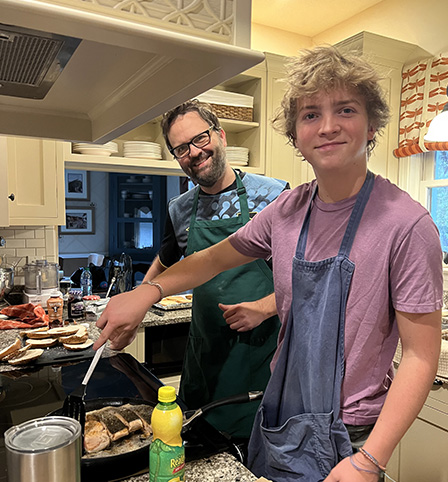 |
Left, below: We decided to squeeze cane late in the afternoon (November 3d) and cook the following day. Thus, we had several hours for activities. What might be appealing to most? Will has had a long-term interest in the classics and likes to try new recipes. Nedra likes to try new recipes. Christine and Harrison like to learn and try new things. That pretty well narrowed it down to making Conditum Paradoxum, a beverage given prominence in Apicius' cookbook (which we had given Will decades ago). There were some glitches: the basic ingredient is wine--Harrison and Christine are underage, Will is a teetotaler, Nedra and I have abstained since the Inconvenience of February 16, 2023. Thus, the wine had to be dealcoholized. Though non-alcoholic wine is sold widely, it only wins positive comments when compared to other less good non-alcoholic wine. Sigh. Moreover, it is produced commercially by advanced techniques such as reverse osmosis, too much for a homeowner. So, WTH, I decided to remove alcohol from some of our homemade wine by fractional distillation. I wrongly imagined that I could bring the temperature up to the boiling point of the water-ethanol azeotrope (173F) and consider it finished when the boiling point crept up a few degrees. Much more complicated, I learned, but we (Harrison, Christine and I) did remove the alcohol over a 2-h period, finally reaching a boiling point of 213F of the concentrate (slightly higher than that of water as it should be.) Then, we added water (to try to bring it back into balance), lots of our stored honey, enough black pepper to disable a mule, some spices, and we were finished. Actually, we sort of enjoyed drinking it at lunch and, for sure, the three of us children enjoyed making it. |
|
|
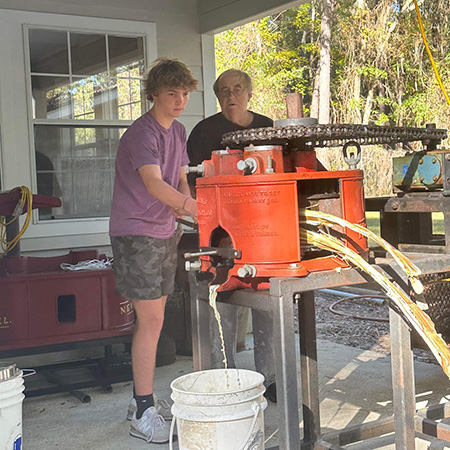 |
Left, below: As mentioned, we used CP 52-48, shown in trailer below, and POJ, not shown (on bottom). This cane was cut within the week of grinding and mostly stored in a building before grinding. I had earlier cut some cane and stored it for two weeks and used some for ice, as will be discussed later. All the juice--fresh cane, stored cane, both cultivars--had a brix of 18.0-18.5 Right, below: Except for the old folks, everybody ground cane. It is fun. L-R, Harrison, Christy, Christine. |
|
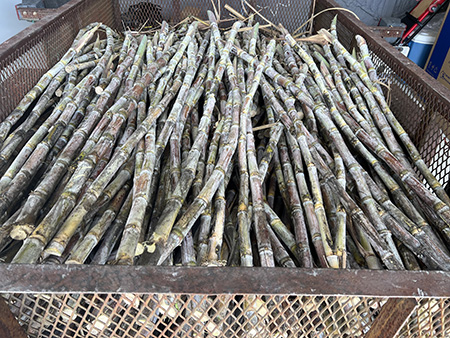 |
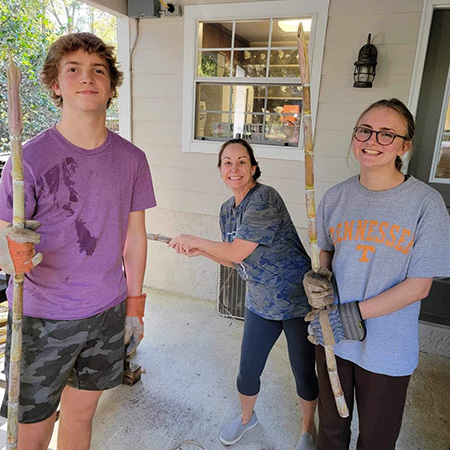 |
| Left, below: Christine, solo on the mill. She probably had one of her boys handing cane to her. As the juice pours from the mill, it passes through two SS sieves. Then, it is filtered through 2 thicknesses of new diapers. I would really like to clean it better before cooking. Right, below: Everyone shared in bagasse management. |
|
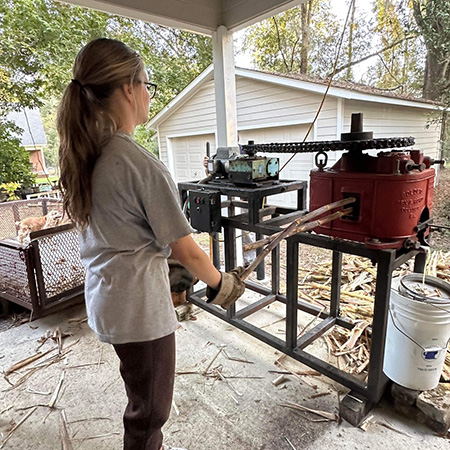 |
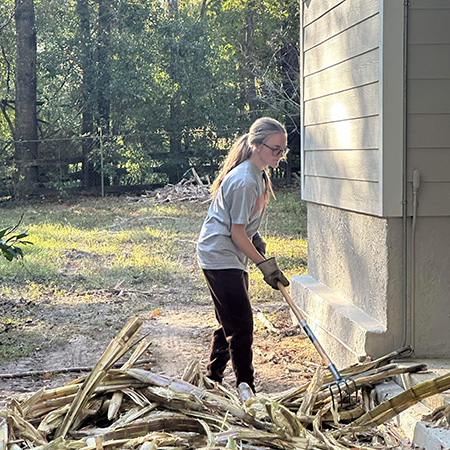 |
| Left, below: Juice was collected in a SS barrel that contained 4 blocks of frozen juice. The blocks had been prepared a couple of weeks earlier by squeezing cane into a container that held frozen ice in milk jugs. Maximum temperature=51F. That cold juice, nom. 16 gallons, was distributed among 4 buffet trays and two freezers, where it was frozen solid. As I believe that sediment is caused at least in part by Leuconostoc, I try to use conditions that are unfavorable for bacterial growth. I also don't store cane, when possible, as I used to. (When I grew cane in Tallahassee for ten years, I never had sediment; now, I grow cane at our farm and sediment has been an issue. Facts are facts even when I can't explain them.) With all juice collected, the barrel was wrapped in bubble wrap for the evening. Right, below: I was chomping at the bits a little harder than the young folks were, but there was no reason to be in a hurry. Christine is shown skimming as Harrison approves. We used a fryer-splatter screen at first and transitioned to a traditional skimmer later. We skim carefully for over an hour before bringing the nascent syrup to a boil. Denatured protein and adsorbed lipids ("skimmings") rise to the top and are easily removed. The fibrils that later become sediment in syrup are heavier than syrup and they tend to distribute homogeneously due to the movement of the liquid. They can be removed by filtration, but I haven't found the perfect way to do it. I would prefer not having sediment, but there are more important issues in my life. I will continue to work on it. Note behind Harrison the plastic sheeting hanging from the ceiling. I put this up temporarily to contain the steam to the area of the kettle. On the wall between the children, the controller for the exhaust fan is on the wall (along with the name plate that hung on my door at work for three decades. |
|
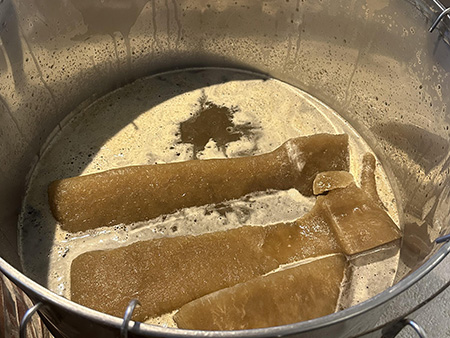 |
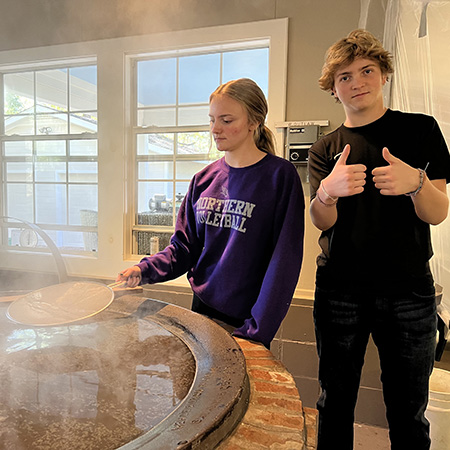 |
Left, below: Will called syrup at 35.5 degrees and filtered the syrup through 4 layers of loose cheesecloth. (Next year, we'll up the filtration some.) Then, he bottled. The last bottle was over 180F, but 165F is high enough. Right, below: Harrison capped and passed to Christine who checked on him and was in charge of post-production management, i.e., inverting the bottles for ten minutes to sterilize the cap and upper parts of the bottle. |
|
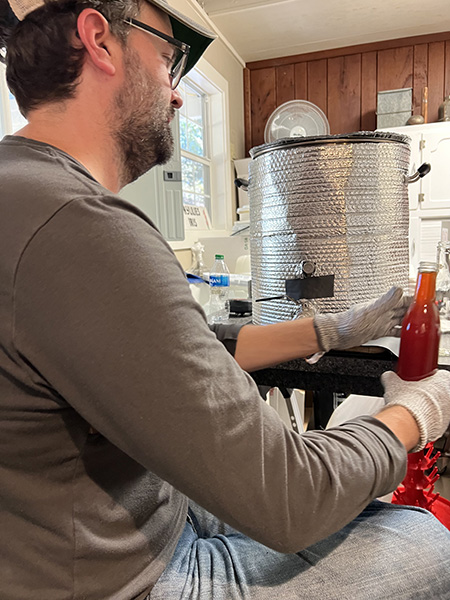 |
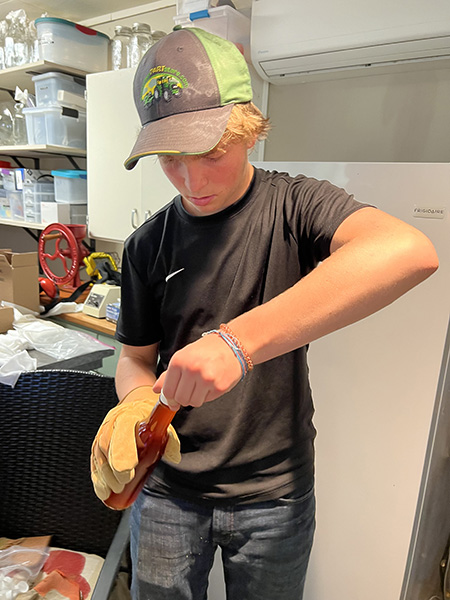 |
| Left, below: I'm proud of these young syrupmakers, but it was hard to get a good photograph. Harrison showed up in the photos as taller than I. Finally, I worked it out by standing on a concrete block and out front. Using this little advantage, he still has a way to go before he is as tall as his granddad. Right, below: Of course, it was sausage and biscuits and syrup for dinner. Harrison learned well from his grandmother how to make biscuits; Will is a self-taught cook. "It was the best we ever made," doesn't everyone say? Certainly we did. I felt the approval of my ancestors tightening their hug around me. Another year in the books. |
|
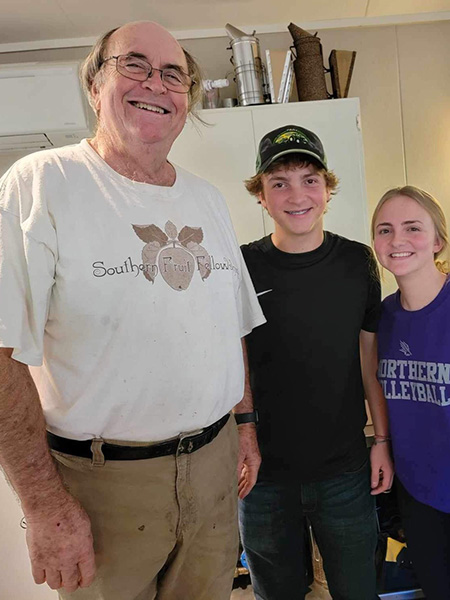 |
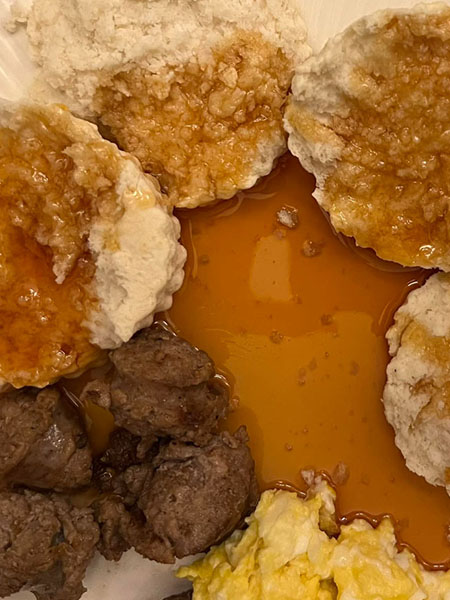 |
Return to Documentation for this page. |
|